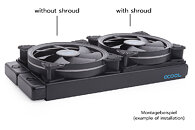Thursday, July 8th 2021

Alphacool Introduces Shroud & Decoupling for Fans and 24-pin PSU Jumper
Today, Alphacool presents the Fan Shroud & Decouplers for 120 mm and 140 mm fans, a must have for performance orientated liquid cooling enthusiasts. These silicon shrouds improve the performance of your liquid cooling system by optimising the airflow through the radiator.
The "dead spot" under the fan hub is overcome as air pressure builds up between the fan and radiator. The airflow is forced through the fins of the radiator as well as preventing air from escaping through gaps. This in turn also reduces the noise created from the escaping air as well as acting as a decoupler to dampen the vibrations being transmitted from the fan to the radiator and potentially to the case.Alphacool also presents a 24-pin ATX PSU Jumper. This is a simple tool that allows you to power your pump whilst keeping the rest of the system dormant, this is particularly useful when you are filling a liquid cooling loop.
The "dead spot" under the fan hub is overcome as air pressure builds up between the fan and radiator. The airflow is forced through the fins of the radiator as well as preventing air from escaping through gaps. This in turn also reduces the noise created from the escaping air as well as acting as a decoupler to dampen the vibrations being transmitted from the fan to the radiator and potentially to the case.Alphacool also presents a 24-pin ATX PSU Jumper. This is a simple tool that allows you to power your pump whilst keeping the rest of the system dormant, this is particularly useful when you are filling a liquid cooling loop.





29 Comments on Alphacool Introduces Shroud & Decoupling for Fans and 24-pin PSU Jumper
I use one of those powered USB 3.0 to SATA connectors, which gives 5V from USB (phone charger or even a battery bank) and 12V from an external source (power brick)
If i'm liquid testing i sure as poop dont want my PSU or anything not the pump to have power...
Somehow never thought about it and had been using the jumper method since long time. :laugh:
I am not sure what is new with this Alphacool 24-pin ATX PSU Jumper.
These things exist since ages. I have one since 2014.
It's kind of worthless for typical desktop heatsinks only because of the weight and bulk it adds to them, and further, the low fan speeds some prefer, although some experimental testing showed shrouding the fan and heatsink worked, but wasn't worth the extra 1-5 degree difference, depending on shroud size, fan speed, and if the heatsink was shrouded (to force the air through all of it rather than escape out the sides). In a number of cases, one can get the same or better performance just strapping a fan on the rear, since most regular desktop heatsinks aren't one big, dense block.
Heck, it's becoming somewhat redundant in the liquid cooling space too, only because newer radiators trend towards low airflow restriction vs the older, high FPI airflow restrictive radiators before, although EU and USA have different opinions on radiator fin density and fan profiles.
www.amazon.com/Coolerguys-Anti-Vibration-Gaskets-120mm-Pack/dp/B07CH78T5M
What kind of pump you have and how high is the power draw and which voltage it needs?
I am not sure if something like that will work for all pumps. :rolleyes:
Most of these USB power adapters that I have are 5V and go maximum to 2.1A. For example Samsung fast charge adapter for my phone can give 2A at 5V.
My DDC Laing 3.2 PWM pump is 12V 18W device and I connect it to PSU while operating the PSU using 24-pin ATX PSU Jumper.
I am not sure if pump will run at 5V.
www.ekwb.com/shop/ek-ddc-3-2-pwm-12v-pwm-pump
This allows the builder to fill and test the cooling loop by itself without powering up the motherboard. I do this.
I pull off the 24-pin ATX cable from the motherboard, add the plug, and power up the PSU to fill and test the cooling loop. That usually requires me to turn the power on/off dozens of times to get the coolant flowing and expel most of the bubbles during a 24 hour test run. Once I am satisfied with the cooling loop operation, I power down the loop, plug the ATX cable back into the motherboard, and power up the system.
Seasonic includes the 24-pin ATX plug with their Focus Gold power supplies.
In my experience, if a loop has a problem, the big leaks are immediately noticeable, the small leaks evident in 5-10 minutes.
And if you have a spare PSU anyhow, why not? I have an old unused PSU that I use for testing new cooling loop components outside of a functional build. It's not like I bought it for that purpose. I already had it.
It is not the most beautiful at the moment. :rolleyes:
Last time I did it little bit quick and dirty.
Next time when I have time want to re-arrange some things especially the tube going over the upper edge of RAM.
More than enough power for a pump, and even fans if needed
The adaptors (the good ones) have a socket for an external 12V power source, which is key to them working in this role